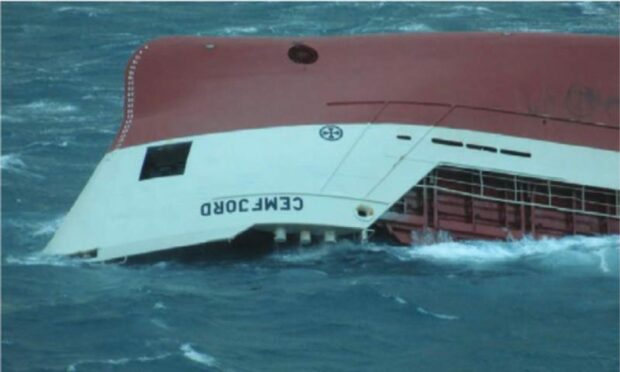A fatal accident inquiry into the death of eight seafarers who died when a cargo vessel capsized “suddenly and violently” off the Pentland Firth has concluded.
MV Cemfjord, a bulk cement carrier, was last recorded travelling west through the Pentland Firth, a stretch of sea between Orkney and the north Caithness coast, on the afternoon of January 2 2015.
It was last heard from at 3pm that day and its upturned hull was discovered by a Northlink ferry Hrossey the next day.
The captain of that ferry, Allan Scott, had delayed his own crossing due to poor weather that day and had it not been for that decision he might never have made the grim discovery, the inquiry at Wick Sheriff Court heard.
Speaking on behalf of the Crown, fiscal depute Stella Swan told the inquiry of the extreme weather conditions the crew faced that afternoon.
Faced extreme waves and winds
“Gusts in excess of 60 to 70 knots and 60 to 90 mph were recorded,” she said.
“Weather was worse than what was forecast. Wave heights were likely to be in the region of 10 metres in the area where the Cemfjord was lost.”
She added that the vessel capsized “suddenly and violently” in what one expert described as “extraordinarily violent breaking seas” as it made its journey from Denmark to Cheshire.
She said the vessel is believed to have suffered a loss of steerage after its speed was drastically reduced by the waves “effectively leaving her at the mercy of oncoming seas”.
Due to its small size, the vessel didn’t have a voyage data recorder, the equivalent of a black box in planes, and Cemfjord’s loss was unobserved from the shore.
Capsize went unnoticed
The 272ft Cyprus-registered vessel’s eight crew have never been found and the wreck, which is lying on the seabed 270ft below sea level has been declared a sea grave.
The crew were the master Pawel Chruscinski, 43, chief officer Jaroslaw Orlov, 45, chief engineer Roman Tamas, 56, and seamen Henryk Dubanowski, 55, Tomasz Kwiatkowski, 31, Artur Podrazka, 24, and Artur Wegorek, also 24, all from Poland.
The eighth member of the crew was Filipino seaman, Jerome Narvasa, 32.
Though findings are yet to be published, the Crown made the suggestion that “deferring entry to the Outer Sound until conditions were more favourable for a westbound transfer could have been one precaution taken”.
That precaution, it is suggested, might have meant the vessel’s speed could have been maintained, meaning the crew could have steered its course and avoided capsizing.
“Its crew were all experienced and dedicated seafarers for whom their final resting place is their ship,” Ms Swan added.
A detailed underwater survey was undertaken in the weeks following the loss of the ship by the Marine Accident Investigation Branch (MAIB). It confirmed no sightings of the missing crew’s bodies.
A subsequent report said the deaths could have been avoided if the master had instead sought shelter.
Barry Smith, representing the ship’s owners, Brise of Hamburg, told the inquiry: “The loss of the master and all seven of his crew was keenly felt through the Brise company.”
The firm flew the crew’s families to the scene of their loved ones’ sea graves to lay wreaths 18 months after the tragedy.
Findings to be translated for families
Sheriff Gary Aitken will deliver his findings within one month.
He added: “This was clearly a tragedy and nothing will ever bring back the officers and crew of the Cemfjord.
“I hope in due course the determination will be a comfort to the crew’s families.”
He asked that his full findings be translated into the first language of the families.

